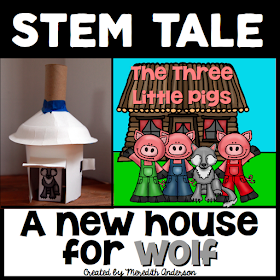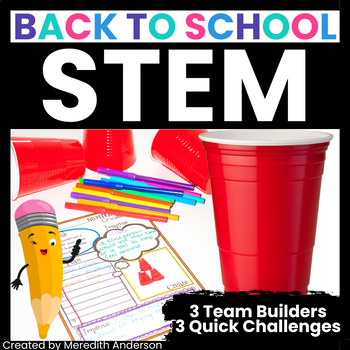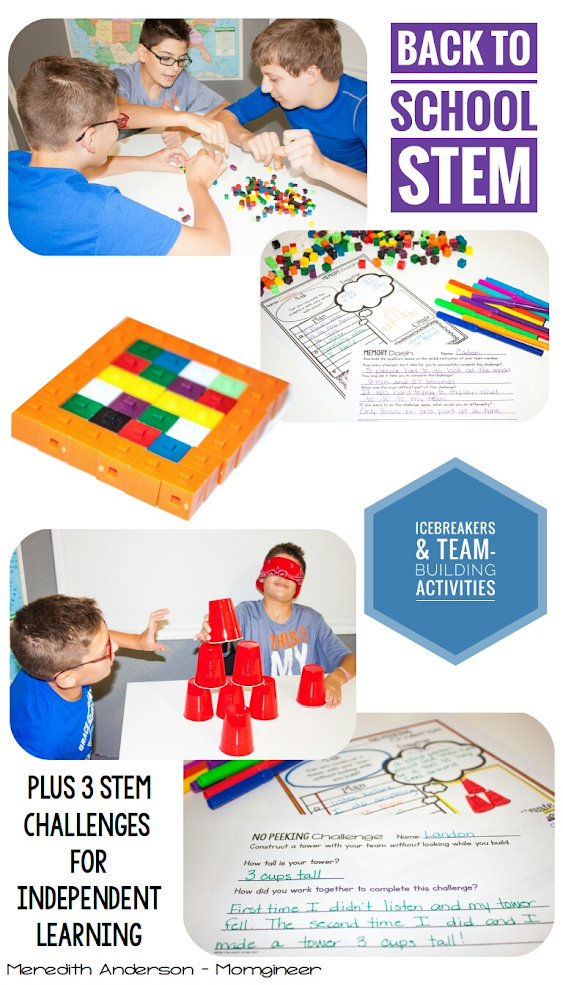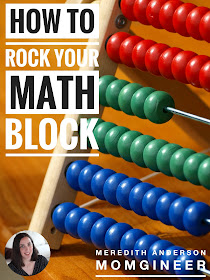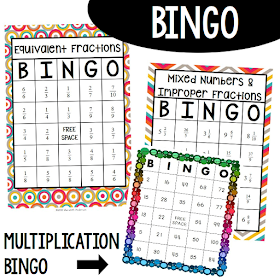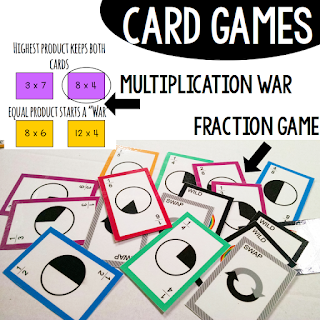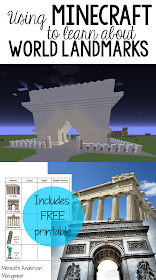Make time for STEM
Let's jump right in!
1. The 3 Exes - Explain, Exhibit, and Expect the Engineering Design Process
Don't worry, I'm not going to ask you to call up your old flames and ask them to come help you facilitate STEM activities with your kiddos! This is a way to easily remember how to introduce and reinforce the STEM methods with your students. If you aren't familiar with the engineering design process, take a peek at this graphic:This is the best way to make STEM go smoothly all year. It's easy for kids to remember these steps (feel free to print out a printer-friendly version of this graphic and sign up for my newsletter for more great STEM freebies). Once they know the steps, and have successfully completed several STEM challenges, they will know where to start and how to progress through the challenge. They will need some assistance the first few times, but they will quickly catch on. One way to always have STEM challenges accessible to your students is to have the first step defined for them. If you need help with this, please visit these free resources: STEM challenge (includes STEM Sticks prompts) or STEM Mats (see the supporting document), or visit STEM Task Cards. This will make sure they get the process started in an appropriate way.
Explain how the engineering design process works. It is a method engineers use when they are trying to solve a problem (see graphic and steps below).
Exhibit the process in action. Take a simple challenge (such as a cup tower challenge) and show them the steps.
Ask - How can I build the tallest tower with 10 cups?
Imagine - What should it look like? Should the base be wide or narrow? Should The cups face up, down, or a mixture of up and down?
Plan - What will the tower look like? Will it have 4 rows, with 4 cups, then 3, then 2, then 1 (as the one shown above)? Is there a better way to make it taller? You can make it much taller than the one shown - see if your students can help you figure out how.
Create - Build the tower. Did it work? I suggest starting with a tower that has a terrible design! Let the cups fall over. Let the kids see you fail. It's not only okay to fail in STEM, it's crucial to developing higher-level critical thinking skills.
Improve - How can you improve the tower to make it more stable or taller?
Reflect - This step isn't always included in the Engineering Design Process but it's important to think about what you did, what worked well or didn't work, and how you might approach the challenge differently if you started again. It's also a great time to get feedback from others. Ask what happens if you change the design criteria (make it the most stable, use 20 cups, use cups made of a different material, etc.). Does it affect the design?
Expect the process will be followed. One way to keep your students accountable is to have a simple recording sheet. I find a one-page graphic organizer is enough for most simple STEM challenges. You can find one included in this free STEM challenge download (or click on either image to download):
2. Delegate STEM Tasks to Students and Parent Helpers
I'll be the first to admit that delegating isn't always something that comes easy. It is usually less hassle to just do things yourself so that they are done just right. If you are anything like me, I'm telling you to just stay with me for a minute while I explain. If you don't feel this way, please share your voodoo mind control magic with me in the comments. If you hate to pass off the control, just know that there are plenty of kids in your classroom who would relish the opportunity to be theTwo ways you can delegate with students:
- Take a small group to be the STEM leaders of a particular challenge, and then send them out to lead their teams through the entire challenge. That leader is responsible for making sure each step is followed in order and that all team members are working together. If you do this, you can then rotate through the groups to work on other small-group tasks, activities, or assessments.
- Explain the challenge to the whole class but have STEM "experts" that float from group to group to help. STEM experts can have any of the following jobs:
- Measurement expert - to check that dimensions are within the criteria.
- Documentation expert - to make sure each step is being recorded, or to help record if not all the kids are able to write. This might be a strong speller or someone who is good at drawing sketches.
- Construction expert - to help with building. These tend to be the tinkerers!
- Quality control / safety expert - to verify everyone is being safe and respectful of the tools and/or materials.
- Photographer - to take photos of the builds in action and the final models.
3. Integrate STEM with other subjects, holidays, and skills.
I know, you already have four subjects (Science, Technology, Engineering, and Mathematics) you are integrating. How can you add more? Very few STEM challenges I have facilitated are truly pure STEM. They are usually some combination of the core STEM subjects, and then something else. What's the something else? It might be fairy tales, history, architecture, music, geography, or even cooking! If you love to present topics in themes throughout your school year, try working STEM into your theme. If you like having activities to go with holidays, use holiday STEM resources. If you love doing the same read-alouds each year, try using those books as jumping points to STEM challenges! Here are some examples:- Fire safety week - design and build a house with several fire escape routes, or design a fire truck that can put out fires easily on multiple levels of a building at once.
- Local geography - map out two points of interest on a local map. Think about a fun or clever way to travel between them in a faster way (Between two friends' homes? Between school and a fun playground nearby?)
- Because of Winn-Dixie STEM - Design and build a prototype for a dog-washing machine, or of a device to keep animals calm.
- Charlotte's Web STEM - Design and construct a spider web of string or pipe cleaners that says a simple word.
- Write and perform a song or a play about the design. Or:
The STEM activity can be a simple but effective way to bring another topic to life. When the challenge is completed, you can tie the activity to the holiday/topic/book and make meaningful connections.Why not have your students create an advertisement about their project? It could be a radio commercial, a newspaper/magazine ad, or video ad. They will be using numerous skills - creative, editing, public speaking, etc. to accomplish this task.
4. Set up a WIP Station in your Classroom, STEM Station, or Makerspace
Say what? This will require a bit of space, but you could even use a laundry basket that stores under a table as your WIP Station or install a shelf where the projects can be kept. WIP, or work in progress, is a way that manufacturers store items that are currently being made but are not finished. If you have a WIP station, your students can then work on their creations when they have finished with other tasks.If you already have a STEM Station or Makerspace, this can be a small addition to it. Keep simple supplies on hand, like paper, cardboard, and tape. You can even set a time limit on how long projects can remain in the WIP station so that they are not indefinitely there. I recommend purging at the end of each month - if it's a project they can take home, send it home! Otherwise have your students disassemble their prototypes and either put the materials back (if they are reusable) or recycle/throw them out.
WIP it good!
5. Scale it back.
This may sound like a contradiction of #3 above (integrate) but I promise it isn't. Spend less of your time "on." Keep it short and sweet. You may even want to record a short video (3-5 minutes) of yourself ahead of time describing the current STEM challenge. If you lead multiple STEM classes, you will be saving yourself even more time by doing this. Keep your part short and transition into more of a support role for your STEM time. The more STEM challenges you do, the more your students will understand the engineering design process and be able to work independently.If you record a video ahead of time, you can then use the time that it's playing to pass out any recording pages or materials to the class. You can also save it for the next year so that you won't have to spend as much prep time re-familiarizing yourself with the challenge.
I hope this gave you some ideas of ways you can make time for STEM in your classroom. Project-based learning is really a cross-curricular way to absorb material, and many kids who don't respond to traditional "book learning" really shine in STEM class.
Want to share this post on Pinterest or keep track of it to refer to later? Use one of these graphics:
Special thanks to Photo Clipz, Glitter Meets Glue Designs, and KG Fonts for the graphics used in this post.























